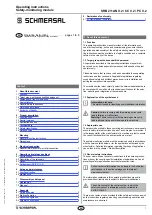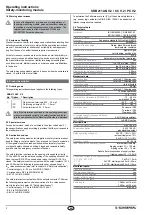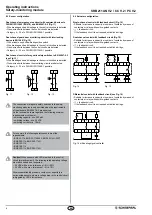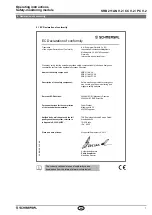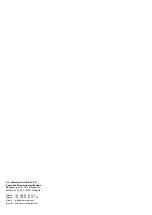
3
SRB 211AN V.2 / CC V.2 / PC V.2
Operating instructions
Safety-monitoring module
EN
Outputs:
Number of safety contacts:
3
Number of auxiliary contacts:
0
Number of signalling outputs:
1
Switching capacity of the safety contacts
(please observe derating curve Section 2.6):
– 13-14, 23-24:
max. 250 V, 8 A ohmic
(inductive in case of appropriate
protective wiring); min. 5 V / 5 mA,
– 37-38:
max. 250 V, 6 A ohmic
(inductive in case of appropriate
protective wiring); min. 10 V / 10 mA
Switching capacity of the signalling outputs:
Y1: 24 VDC / 100 mA
Fuse rating of the safety contacts:
external (I
k
= 1000 A)
to EN 60947-5-1
- 13-14, 23-24 (STOP 0):
Safety fuse 10 A quick blow, 8 A slow blow
- 37-38 (STOP 1):
Safety fuse 8 A quick blow, 6.3 A slow blow
Fuse rating of the signalling output:
Y1: 100 mA
(internal electronic trip F4)
Utilisation category to EN 60947-5-1:
AC-15, DC-13
Dimensions H x W x D:
SRB 211AN/PC V.2: 100 × 22.5 × 121 mm
SRB 211AN V.2: 120 × 22.5 × 121 mm
SRB 211AN/CC V.2: 130 × 22.5 × 121 mm
The data specified in this manual are applicable when the
component is operated with rated operating voltage U
e
±0%.
2.5 Safety classification
Standards:
EN ISO 13849-1, IEC 61508, EN 60947-5-1
PL:
STOP 0: up to e, STOP 1: up to d
Category:
STOP 0: up to 4, STOP 1: up to 3
PFH value:
STOP 0: ≤ 2.0 x 10
-8
/h,
STOP 1: ≤ 2.0 x 10
-7
/h
DC:
STOP 0: 99% (high),
STOP 1: > 60% (low)
CCF:
> 65 points
SIL:
STOP 0: up to 3, STOP 1: up to 2
Service life:
20 years
The PFH values of 2.0 x 10
-8
/h and 2.0 × 10
-7
/h applies to the combina-
tions of contact load (current through enabling contacts) and number of
switching cycles (n
op/y
) mentioned in the table below. At 365 operating
days per year and a 24-hours operation, this results in the below-menti-
oned switching cycle times (t
cycle
) for the relay contacts.
Diverging applications upon request.
Contact load
n
op/y
t
cycle
20 %
525,600
1.0 min
40 %
210,240
2.5 min
60 %
75,087
7.0 min
80 %
30,918
17.0 min
100 %
12,223
43.0 min
2.6 Derating curve
21 A
18 A
15 A
12 A
9 A
6 A
3 A
0 A
35 C
40 C
45 C
50 C
55 C
60 C
65 C
Fig. 1:
vertical = residual current;
horizontal = ambient temperature;
continuous line: operating voltage/thermal test current DC;
dashed line: operating voltage/thermal test current AC.
Mounting distance to other safety-monitoring modules as of a residual
current > 6 A: at least 10 mm
Derating curve depending on the rated operating voltage U
e
of the SRB
safety-monitoring module.
3. Mounting
3.1 General mounting instructions
Mounting: snaps onto standard DIN rails to EN 60715.
Snap the bottom of the enclosure slightly tilted forwards in the DIN rail
and push up until it latches in position.
3.2 Dimensions
All measurements in mm.
Device dimensions (H/W/D):
SRB 211AN/PC V.2: 100 × 22.5 × 121 mm
SRB 211AN V.2:
120 × 22.5 × 121 mm
SRB 211AN/CC V.2: 130 × 22.5 × 121 mm
4. Electrical connection
4.1 General information for electrical connection
As far as the electrical safety is concerned, the protection
against unintentional contact of the connected and therefore
electrically interconnected apparatus and the insulation of the
feed cables must be designed for the highest voltage, which
can occur in the device.
The electrical connection may only be carried out by
authorised personnel in a de-energised condition.
Wiring examples: see appendix
To avoid EMC disturbances, the physical ambient and
operational conditions at the place where the product is ins-
talled, must meet the provisions laid down in the paragraph
"Electromagnetic Compatibility (EMC)" of DIN EN 60204-1.
5. Operating principle and settings
5.1 LED functions
• K1: Status channel 1
• K2: Status channel 2
• K3: Status delayed enabling circuit channel 1
• K4: Status delayed enabling circuit channel 2
• U
B
: Status operating voltage (LED is on, when the
operating voltage on the terminals A1-A2 is ON)
• U
i
: Status internal operating voltage (LED is on, when the
operating voltage on the terminals A1-A2 is ON and
the fuse has not been triggered).

